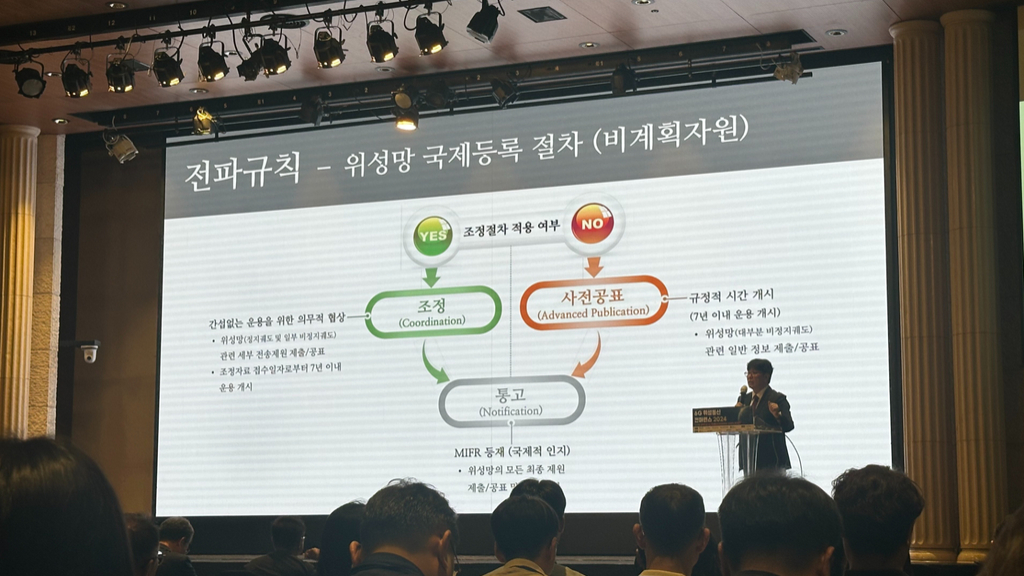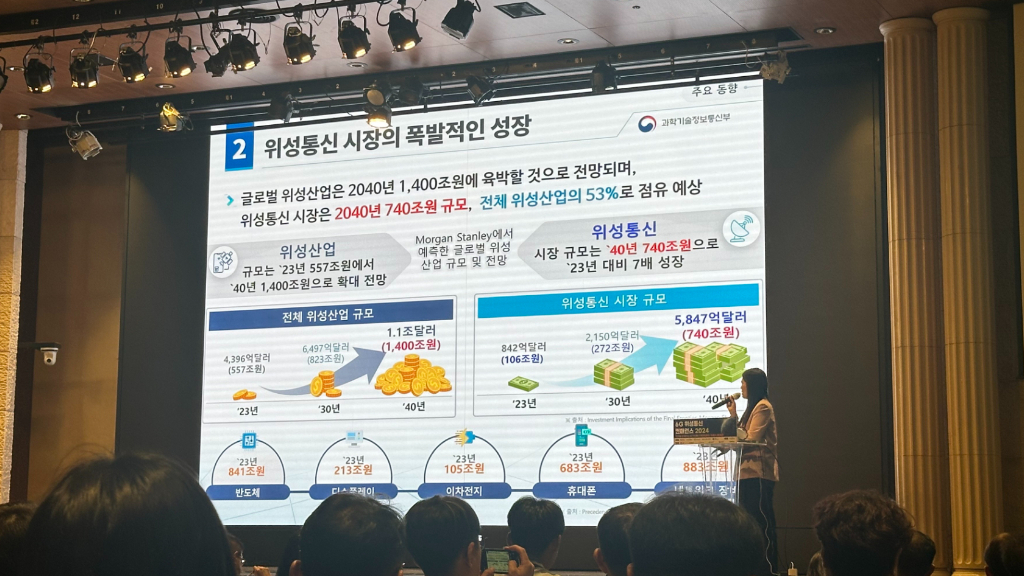2030년 6G 표준 기반 저궤도 위성통신 상용화를 위한 논의의 장이 마련됐다. 글로벌 선점 경쟁이 치열한 가운데 현재 보유한 위성 궤도/주파수를 보호하면서 동시에 신규 자원을 확보해야 한다는 전문가의 의견이 제시됐다.
▲과기부 지은경 과장
2024년 5월 저궤도 위성통신 3번째 도전 ‘통과’
韓, 6G 표준 기반 2030년대 저궤도 위성통신 상용화 목표
궤도/주파수 확보 경쟁 치열…”중장기적 전략 강화 必”
2030년 6G 표준 기반 저궤도 위성통신 상용화를 위한 논의의 장이 마련됐다. 글로벌 선점 경쟁이 치열한 가운데 현재 보유한 위성 궤도/주파수를 보호하면서 동시에 신규 자원을 확보해야 한다는 전문가의 의견이 제시됐다.
올해로 3번째 ‘6G 위성통신 컨퍼런스 2024’가 16일 양재 엘타워에서 열렸다. 이번 행사는 2024 ICT 표준화 포럼 지원 사업에 참여하고 있는 위성통신포럼과 ETRI, 한국통신학회, 한국전자파학회, 위성정보통신학회가 공동 개최했다. 이날 산학연관 전문가들은 ‘디지털 강국의 길, 6G 위성통신으로 완성하는 차세대 네트워크’를 주제로, 6G 위성통신 정책 및 동향, 6G 위성통신 표준활동에 대해 발표했다.
과기부 강도현 차관은 축사에서 “저궤도 위성통신 기술 개발 사업이 지난 5월 예타가 통과됐고, 국제표준화기구에서도 표준화 논의가 활발한 상황이다. 위성통신의 가능성이 온 분야로 퍼져 있는 지금이 국내 기업들의 시장 참여 독려를 위한 적기다. 산학연의 협력으로 하나의 프로젝트처럼 투자하는 것이 중요하며, 정부도 여정을 함께하겠다”고 전했다.
모건 스탠리에 따르면 2040년 위성 산업 규모는 1,400조원, 이중 위성통신은 740조원 규모로 53%를 점유할 것으로 전망된다. 스페이스X, 원웹 등 글로벌 기업은 재활용 가능한 저궤도 위성 개발을 기점으로 본격 시장 선점에 나섰다. 스페이스X는 2030년까지 4만 2천여기의 위성을 발사할 목표를 밝혔다.
우리나라는 2023년 2월 K-네트워크 2030 전략을 발표하고, K-네트워크 전략 핵심 중 하나로 저궤도 위성통신을 제시했다. 과기부 지은경 과장은 “3GPP(글로벌 이동통신 표준화 기구)는 6G에서 NTN(비지상 네트워크)로 표준화를 시작해 2028년까지 6G 표준을 완료할 계획이다. 우리나라는 6G 표준을 바탕으로 2030년대 저궤도 위성통신 상용화를 목표한다”고 말했다.
저궤도 위성통신 시스템 개발 및 검증으로 통신탑재체, 지상국, 단말국, 본체, 위성 체계 등 5대 분야에서 11개 핵심기술을 확보하는 것이 골자다. 지은경 과장은 “위성통신 시장 선점은 기술적 난이도가 높고, 거대 자본을 필요로 하기 때문에 하나의 기업이 추진하기 어려우며 정부의 마중물 역할이 필요하다”고 말했다.
 ▲ETRI 박종민 박사
▲ETRI 박종민 박사
ETRI 박종민 박사는 저궤도 위성 사업을 위해 궤도/주파수 확보가 선제적으로 추진돼야 함을 강조하며, “아무리 뛰어난 위성 기술 및 부품이 개발돼도 결국 궤도/주파수 자원이 없으면 쓸 수가 없다”고 주장했다.
그러나 현실은 기존의 정지궤도도 확보하기 어려운 실정이다. 예컨대 한중일에서 중국은 73개, 일본은 23개에 비해 우리나라는 8개만의 정지궤도만을 확보하고 있다. 또한 IMT용 검토 대역 내 위성업무 분배 현황을 보면 국내 위성이 운용중인 7-8GHz 주파수 대역을 비롯한 주파수 공유 요구가 심화되고 있다.
박종민 박사는 “ITU(국제전기통신연합)이 궤도/주파수를 공평하게 활용하기 위해 주파수 분배 규정 및 절차를 명시하고 있지만, 점차 한정된 자원인 위성 궤도/주파수 자원 확보 경쟁이 치열해짐에 따라 위성업무용 뿐만 아니라 지상업무용 가용 주파수 대역이 제한될 수 있다”고 언급했다.
그러면서 “이에 따라 위성 산업이 본격 꽃피우기 전, 정부는 전파 규칙의 절차를 준수하면서 우리나라의 주파수 자원 확보 및 보호 방안을 강화하는 중장기적인 정책을 마련해야 한다”고 주장했다.

